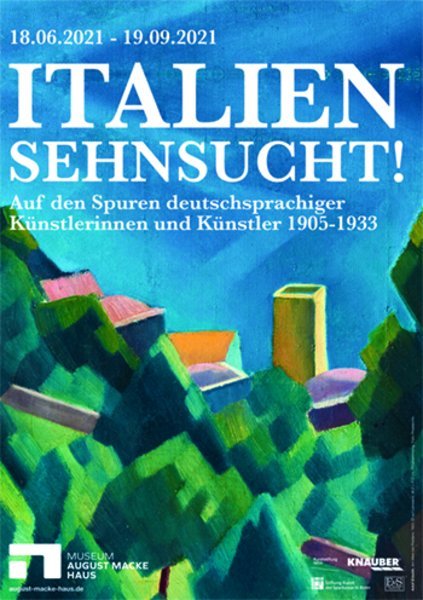Longing for Italy! On the trail of German-speaking artists 1905 – 1933
Museum im Kulturspeicher, Würzburg
November 2020 – March 7, 2021
Kunstsammlungen Zwickau Max Pechstein Museum
March 27 – May 30, 2021,
Museum August Macke Haus, Bonn
June 2021 – September 19, 2021
Italy – at the latest since Goethe’s journey (1786-88), a destination of longing and the epitome of a paradisiacal Arcadia for “northerners”! The abundance of works of art in the churches, palazzi and museums alone attracted educational travelers as well as artists from all over the world. In addition, the southern sun, the Mediterranean landscape and the good life beckoned.
Even though Paris became the art capital of Europe at the beginning of the 20th century, Italy remained a sought-after destination for the young generation of artists – especially when this was linked to a scholarship at the German artists’ residences, the Villa Romana in Florence or the Villa Massimo in Rome. Both institutions were formed in 1905 and 1910 respectively – at the height of Expressionism. Karl Schmidt-Rottluff, Helmuth Macke and Max Peiffer Watenphul, for example, came to Rome on scholarships. Ernst Barlach, Max Beckmann, Dora Hitz and Hans Purrmann, among others, worked in the Villa Romana, which was acquired by Max Klinger.
August Macke, Erich Heckel, Max Pechstein and Walter Ophey explored Italy on their own before the outbreak of the First World War. Wassily Kandinsky and Gabriele Münter spent precious months together on the Ligurian coast. Other artist couples, such as Gertrud Alber-Eberz and Josef Eberz or Maria Caspar-Filser and Karl Caspar, discovered the Italian landscape around Florence, on the Amalfi Coast or in Umbria together. In the early 1920s, a lively artists’ colony developed in Positano, where Anita Rée, Carlo Mense and Richard Seewald, among others, settled. Adolf Erbslöh painted heroic-pathetic landscapes there – comparable to the monumental compositions of his friend Alexander Kanoldt. Italy became a second home for Werner Gilles, Hans Kuhn and Eduard Bargheer.
For the first time, an exhibition is dedicated to German artists’ travels to Italy between 1905 and 1933: Expressionist drama and New Objectivity coolness – both temperatures can be found in the examination of the country, its cities and places, its people, its landscape and its legends. The exhibition with around 100 paintings, works on paper, photographs and sculptures by 30 artists between 1905 and 1933 impressively illustrates the great importance of Italy for the German avant-garde.
The exhibition, curated by Martina Padberg, is a cooperation between the Museum August Macke Haus, the Museum im Kulturspeicher Würzburg and the Kunstsammlungen Zwickau – Max Pechstein Museum.
The exhibition is accompanied by a catalog published by Wienand-Verlag.

